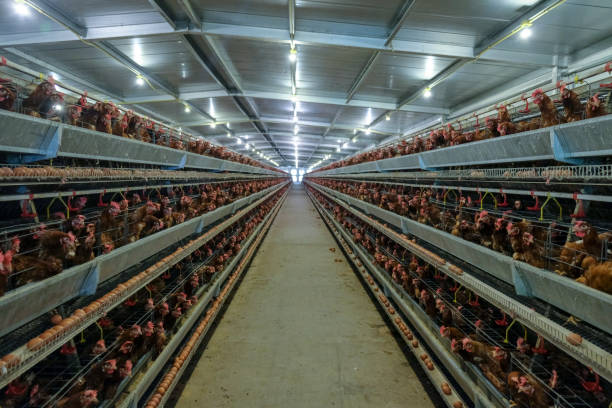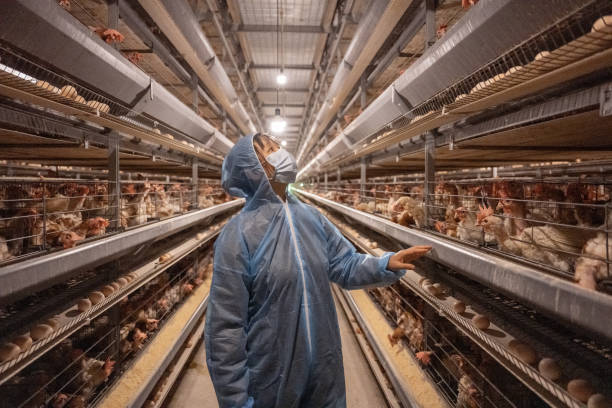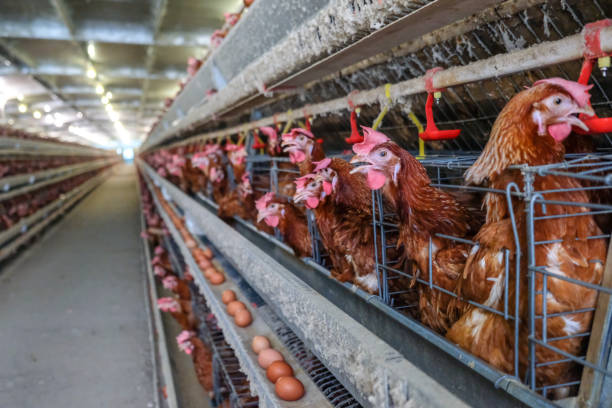
Indonesia: Scaling Your Chicken Farm to 50,000 Birds with Battery Cages
Indonesia: Scaling Your Chicken Farm to 50,000 Birds with Battery Cages
Indonesia’s poultry industry is experiencing a significant boom, driven by increasing domestic demand for both eggs and chicken meat. For Indonesian farmers looking to capitalize on this growth, scaling up their operations is the key. A popular strategy for achieving this scale efficiently and profitably is by utilizing battery cages for egg-laying hens or broiler chickens. This article will explore how Indonesian farmers can successfully scale their chicken farms to 50,000 birds using battery cage systems, covering crucial aspects like planning, cage selection, environmental control, feeding and watering, waste management, disease prevention, and operational best practices.
Laying the Foundation: Planning is Paramount
Before investing in any equipment or infrastructure, a solid plan is absolutely essential. Scaling to 50,000 birds is a major undertaking, requiring careful consideration of several critical factors.
Market Analysis: Understand your target market. Who are your customers? What are their preferences regarding egg size, shell color, and overall egg quality? What are the prevailing market prices, and how do they fluctuate seasonally? For broiler farming, analyze the demand for different sizes of chickens and the preferred processing methods in your area.
Financial Planning: Develop a detailed business plan that includes projected startup costs, operating expenses, and revenue streams. Secure funding through loans or investors. Calculate your return on investment (ROI) and break-even point to understand the financial feasibility of your project. Don’t forget to factor in potential risks like disease outbreaks and fluctuating feed prices.
Location, Location, Location: Choose a suitable location for your farm. Key considerations include: proximity to markets (to reduce transportation costs), access to reliable water and electricity, availability of labor, distance from residential areas (to minimize noise and odor complaints), and biosecurity measures (isolation from other poultry farms to prevent disease spread).
Regulatory Compliance: Familiarize yourself with and adhere to all relevant Indonesian regulations concerning poultry farming, environmental protection, and animal welfare. Obtain the necessary permits and licenses before commencing operations.
Cage Selection: Choosing the Right Homes for Your Flock
Battery cages remain a popular choice for large-scale chicken farming due to their efficiency in space utilization, improved hygiene, and ease of management. However, the specific type of cage you choose will depend on whether you are raising laying hens or broiler chickens.
Laying Hen Cages: These cages are typically designed for multiple birds per cage, allowing for efficient space utilization. Consider factors like cage size, number of birds per cage, ventilation, manure removal system, and accessibility for egg collection. Automatic egg collection systems can significantly reduce labor costs. Look for cages made from durable, corrosion-resistant materials to ensure longevity. Modern battery cages often include features like nipple drinkers and feed troughs designed to minimize feed wastage.
Broiler Chicken Cages: Broiler cages are designed to accommodate the rapid growth of broiler chickens. They typically have larger floor spaces than laying hen cages and are constructed to allow for easy access for feeding, watering, and cleaning. The comfort of the birds is paramount to ensure optimum growth rates and minimize injuries. Consider cages with smooth, non-abrasive surfaces to prevent breast blisters and other injuries.
Cage Material and Construction: Opt for cages made from galvanized steel or other corrosion-resistant materials. The cage design should be sturdy and durable, capable of withstanding the daily wear and tear of a large-scale operation. Ensure that the cages are easy to clean and disinfect to maintain a hygienic environment.
Creating the Perfect Environment: Environmental Control is Crucial
Maintaining a stable and comfortable environment is critical for maximizing productivity and minimizing stress on your birds. Environmental control includes managing temperature, humidity, ventilation, and lighting.
Temperature Control: Chickens are sensitive to temperature fluctuations. Implement systems to maintain optimal temperatures for both laying hens and broiler chickens. This may involve using fans, heaters, and insulation to regulate the temperature inside your poultry houses. In Indonesia’s tropical climate, ventilation is particularly important to prevent heat stress.
Humidity Control: High humidity can create a breeding ground for bacteria and promote disease. Ventilation is key to controlling humidity levels. Consider using dehumidifiers if humidity becomes a persistent problem.
Ventilation: Proper ventilation removes stale air, reduces humidity, and provides fresh oxygen. Natural ventilation can be effective in some climates, but mechanical ventilation systems offer greater control and consistency, especially in large-scale operations. Ensure that your ventilation system is adequate to handle the needs of 50,000 birds.
Lighting: Lighting plays a crucial role in egg production and broiler growth. Implement a lighting program that stimulates egg laying in hens or promotes rapid weight gain in broilers. Use timers to regulate the length and intensity of light exposure. Studies have shown that specific lighting schedules can significantly improve egg production and feed conversion rates.
Nourishing Your Flock: Feeding and Watering Systems
Providing your birds with a consistent supply of fresh feed and water is essential for their health, growth, and productivity.
Feeding Systems: Automatic feeding systems can significantly reduce labor costs and ensure that all birds receive adequate feed. Consider using chain feeders or auger systems to distribute feed evenly throughout the poultry houses. Monitor feed consumption regularly to identify any potential health problems or feeding inefficiencies.
Watering Systems: Nipple drinkers are a popular choice for battery cage systems as they minimize water wastage and reduce the risk of contamination. Ensure that all birds have access to fresh, clean water at all times. Regularly check and maintain your watering system to prevent leaks and blockages. Consider supplementing the water with vitamins and electrolytes, especially during periods of stress or disease outbreaks.
Feed Formulation: Work with a nutritionist to develop a feed formulation that meets the specific nutritional needs of your birds. The feed should be balanced in terms of protein, energy, vitamins, and minerals. Use high-quality feed ingredients and avoid using feed that is moldy or contaminated.
Waste Management: A Sustainable Approach
Managing poultry waste effectively is crucial for protecting the environment, preventing disease, and maintaining good relations with your neighbors.
Manure Removal Systems: Battery cage systems typically include manure removal systems that simplify the process of removing manure from the poultry houses. These systems can range from simple scraper systems to more sophisticated conveyor belt systems.
Manure Processing: Consider implementing a manure processing system to convert the manure into a valuable fertilizer. Composting is a popular method for processing poultry manure. The compost can be sold to local farmers or used to fertilize your own land.

Odor Control: Poultry manure can generate unpleasant odors. Implement measures to minimize odor emissions, such as using covered manure storage facilities and applying odor-absorbing substances to the manure.
Disease Prevention: Protecting Your Investment
Disease outbreaks can be devastating to a large-scale poultry operation. Implement a comprehensive biosecurity program to prevent the introduction and spread of disease.
Biosecurity Measures: Restrict access to your farm, implement strict hygiene protocols, and disinfect equipment regularly. Use foot baths and hand sanitizers at all entry points. Control rodents and wild birds, as they can carry diseases.
Vaccination Programs: Consult with a veterinarian to develop a vaccination program that protects your birds against common poultry diseases in Indonesia. Adhere to the vaccination schedule strictly.
Monitoring and Surveillance: Regularly monitor your birds for signs of illness. Implement a surveillance program to detect diseases early. Submit samples to a diagnostic laboratory for testing if you suspect a disease outbreak.
Operational Best Practices: Running a Tight Ship

Efficient management is critical for maximizing productivity and profitability.
Record Keeping: Maintain detailed records of feed consumption, egg production, mortality rates, and other key performance indicators. Analyze these records regularly to identify trends and areas for improvement.

Staff Training: Provide your staff with adequate training on all aspects of poultry farming, including feeding, watering, disease prevention, and waste management.
Continuous Improvement: Stay up-to-date on the latest advancements in poultry farming technology and management practices. Attend industry conferences and workshops to learn from experts.
Emergency Planning: Develop a plan for dealing with emergencies, such as power outages, disease outbreaks, and natural disasters.
Scaling your chicken farm to 50,000 birds using battery cages is a significant investment, but with careful planning, sound management practices, and a commitment to biosecurity, Indonesian farmers can achieve success and contribute to the growth of the poultry industry. Remember to prioritize animal welfare, environmental sustainability, and continuous improvement to ensure the long-term viability of your operation. By embracing these strategies, you can unlock the potential of your farm and reap the rewards of a thriving poultry business in Indonesia.
